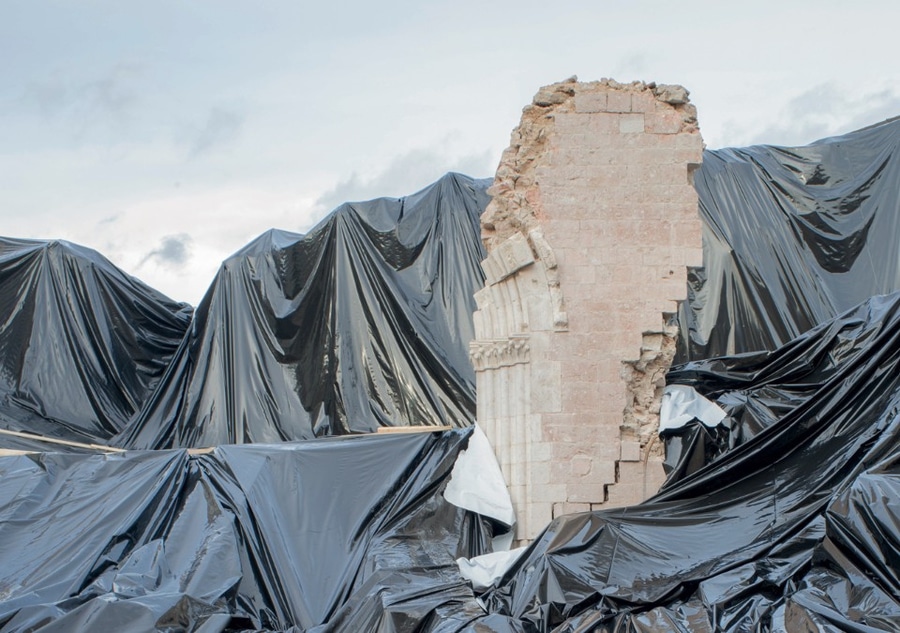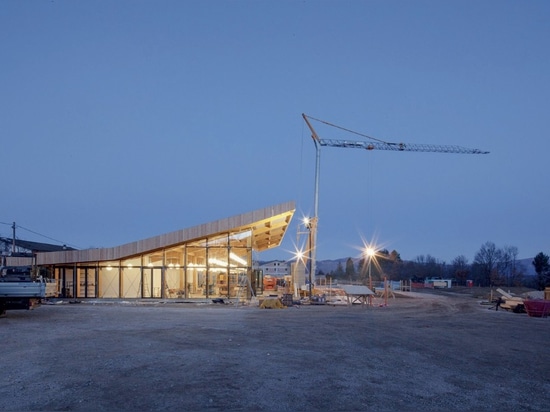
#PUBLIC ARCHITECTURE PROJECTS
Seismic Italy
Italian reconstruction is of the quantitative, not the qualitative type: the seismic sequence that has been devastating the country nonstop since 2009 has laid bare a cultural outlook. It shows behaviour oblivious to the events that have occurred over the past 50 years in the history of Italian earthquakes.
Italy is fragile. The seismic sequence that has been devastating the country nonstop since 2009 has laid bare a cultural outlook. It shows behaviour oblivious to the events that have occurred over the past 50 years in the history of Italian earthquakes. Following the 3 recent earthquakes, the policies for dealing with catastrophes, preserving historical heritage, installing temporary housing and completing new reconstruction projects are uncoordinated, isolated and marginal episodes. Faced with more than 50,000 buildings to be rebuilt, needing an investment of over 20 billion euros of public money, Italian reconstruction is of the quantitative, not the qualitative type.
We have broken off continuity with the past, when there used to be a succession of collective projects that generated models, experimental laboratories and narratives: Alberto Burri’s cretto in Belice, the fieldwork by intellectuals and architects assembled by Pierluigi Nicolin; and the direct involvement of Andy Warhol and Joseph Beuys in Naples. Or the system in Friuli, capable of uniting the principle of reconstruction “where it was, as it was” with cutting-edge research that produced outstanding architecture in the factories designed by Gino Valle. On rereading these stories today, they sound like truly generous achievements, with debate being followed by action. Today, everything is subordinated to political circumstances. The “method” of intervention reflects an exclusively economic logic and a limited outlook. It is a failure of ideas.
Stefano Boeri, civic centre, Norcia 2016 Top: Norcia, September 2016. The Basilica of San Benedetto during initial safety operations conducted by the fire department. Photo Antonio Di Cecco. Above: Stefano Boeri, civic centre, Norcia 2016 Pin It
Chapter 1: L’Aquila 2009 – 2017
Reconstruction after earthquakes is one of the stumbling blocks in Italy today. In L’Aquila, the red zone (the inner city destroyed by the earthquake) still looks like a ghost town. The C.A.S.E. (prefabricated emergency housing) model understandably stirred controversy and failed to solve the real problems of designing adequate housing. It is still a negative symbol of the Abruzzo earthquake. Clearly the issues are far more complex. Quality works such as Renzo Piano’s Auditorium or Shigeru Ban’s Concert Hall are not enough. They are propitiatory architectural works dispersed over an area whose identity and specific character need to be urgently enhanced as the basis for reconstruction. In such situations it is essential to rediscover the lost traces and elements of spontaneous and anonymous architecture. We need to reclaim the signs capable of embodying the significance of the project by focusing on the peculiarities of the site. We also need to minimise the prevailing technical, self-referential visual languages that are alien to the context and connected with a cosmopolitan kind of architecture.
Renzo Piano Building Workshop, auditorium in the park, L’Aquila 2012. Photo Marco Caselli_Nirmal Renzo Piano Building Workshop, auditorium in the park, L’Aquila 2012. Photo Marco Caselli_Nirmal
Pin It
Chapter 2: Emilia 2012 – 2017
As in Irpinia in 1980, the evacuees in Emilia are still accommodated in modest rows of construction shacks. The work of Elemental or Toyo Ito is unknown here. The earthquake in Emilia is seen as mainly destroying factory buildings. There were “only” 27 deaths, most of them caused when isostatic structures collapsed because beams were simply supported on pillars without being securely fastened. The essential geography of the Po Valley is being altered by the dynamics of reconstruction, which is doing more damage than the earthquake itself. The typical cascine a corte farmhouses made famous in photographs by Luigi Ghirri and stories by Giovannino Guareschi are a piece of that endangered Italian landscape. Historically distinguished by their geometric purity and simple forms, they have been demolished and replaced by prefabricated houses made of wood lined with thermal insulation, PVC and plasterboard. Whether they were rebuilt as clumsy replicas or as simulacra of mountain cabins from Trentino hardly matters.
True, Emilia disregarded the urban plan of the new towns of L’Aquila in favour of tract housing: homes scattered across the countryside, oddly and disjointedly erected without any attempt to relate them to their surroundings. The primary services of the towns have been concentrated in new clusters, grown in on the edges of the old town centres. These town halls, schools and sports halls built on valuable farmland will remain as an incomprehensible testament to the disaster, connected at random without a project. This is the new “Emilia outlet” style, not very different from the themed mall villages strung along the motorways. Mario Cucinella’s nursery school at Guastalla, Carlo Ratti’s Learning Garden at Cavezzo, the church by Davide Marazzi at Medolla, Paolo Didonè’s schools or the day-care centres by Mauro Frate are vain attempts eclipsed by thousands of insignificant buildings slapped together by contractors and architects without any concern for the quality of the built environment or the values of this region.
Shigeru Ban, concert hall, L’Aquila 2011. Photo Didier Boy de la Tour Shigeru Ban, concert hall, L’Aquila 2011. Photo Didier Boy de la Tour Pin It
Chapter 3: Central Italy 2016 – 2017
The real risk is a loss of bearings. Everywhere the spate of new buildings will make these areas unrecognisable with destructive intrusions and the defilement of the landscape. For the hundreds of villages linked by footpaths and peasant farms making up this stretch of the Apennine ridge, the future is precarious. The assembly of temporary emergency modules in the form of tents and grey-panelled container homes is being repeated with the same methodical regularity we have seen before. The alternative proposed by Shigeru Ban to make rooms by installing paper partitions fixed to cardboard tubes in the sports hall at Camerino was a partial exercise that was not concretised in a solution that could be extended and diffused. Apart from Stefano Boeri’s already operational canteen at Amatrice, construction is proceeding slowly with lacklustre infill buildings. Even in these places, the traditional sandstone buildings will be replaced by technological wooden prefabs.
Carlo Ratti Associati, learning garden and school gymnasium, Cavezzo 2014 Carlo Ratti Associati, learning garden and school gymnasium, Cavezzo 2014 Pin It
As you wander through Accumoli, Arquata or Norcia, you realise how the earthquake has devastated an artistic heritage so immense that it is impossible to recuperate its history. While the “light building sites” and the ten prototypes being developed by Renzo Piano with the G124 group at the Senate entrust the protection of Italy to the need for prevention, there remains the dilemma of how and where to rebuild. Specifically: are the design of the new and the restoration of the old now irreconcilable architectural approaches? We will probably never get an answer, since the good practice of the profession has been ousted from every possible application. Certainly, unless architecture is rooted in tradition, the levelling force of reconstruction will irreversibly disrupt the thousand different Italian landscapes with a large number of solutions that have not been conceived beforehand. This will accelerate the homogenisation of the country, which is the antithesis of the variegated local characters typical of the peninsula. By irremediably destroying that inseparable and typically Italian union between architecture and environment, these “singular objects” are projecting us towards a future that is increasingly insecure.



